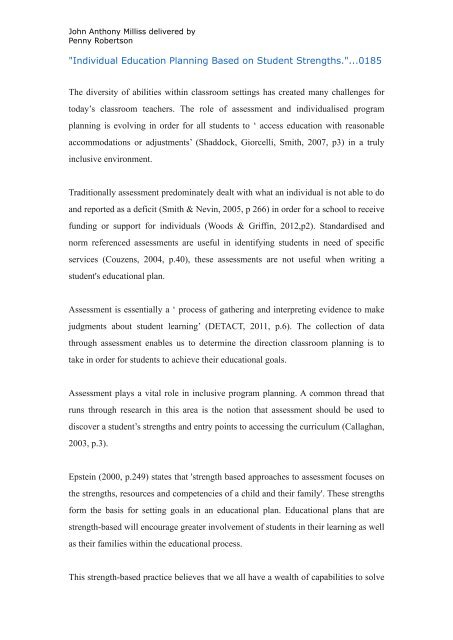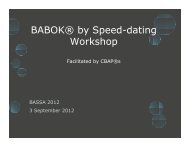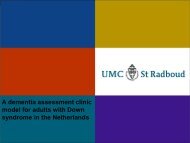here - SBS Documents
here - SBS Documents
here - SBS Documents
Create successful ePaper yourself
Turn your PDF publications into a flip-book with our unique Google optimized e-Paper software.
John Anthony Milliss delivered by<br />
Penny Robertson<br />
"Individual Education Planning Based on Student Strengths."...0185<br />
The diversity of abilities within classroom settings has created many challenges for<br />
today’s classroom teachers. The role of assessment and individualised program<br />
planning is evolving in order for all students to ‘ access education with reasonable<br />
accommodations or adjustments’ (Shaddock, Giorcelli, Smith, 2007, p3) in a truly<br />
inclusive environment.<br />
Traditionally assessment predominately dealt with what an individual is not able to do<br />
and reported as a deficit (Smith & Nevin, 2005, p 266) in order for a school to receive<br />
funding or support for individuals (Woods & Griffin, 2012,p2). Standardised and<br />
norm referenced assessments are useful in identifying students in need of specific<br />
services (Couzens, 2004, p.40), these assessments are not useful when writing a<br />
student's educational plan.<br />
Assessment is essentially a ‘ process of gathering and interpreting evidence to make<br />
judgments about student learning’ (DETACT, 2011, p.6). The collection of data<br />
through assessment enables us to determine the direction classroom planning is to<br />
take in order for students to achieve their educational goals.<br />
Assessment plays a vital role in inclusive program planning. A common thread that<br />
runs through research in this area is the notion that assessment should be used to<br />
discover a student’s strengths and entry points to accessing the curriculum (Callaghan,<br />
2003, p.3).<br />
Epstein (2000, p.249) states that 'strength based approaches to assessment focuses on<br />
the strengths, resources and competencies of a child and their family'. These strengths<br />
form the basis for setting goals in an educational plan. Educational plans that are<br />
strength-based will encourage greater involvement of students in their learning as well<br />
as their families within the educational process.<br />
This strength-based practice believes that we all have a wealth of capabilities to solve
John Anthony Milliss delivered by<br />
Penny Robertson<br />
problems as stated by Callaghan (2003, p.2). When we focus on what a student is able<br />
to do the chance of a student's success within the curriculum is greater. T<strong>here</strong>fore,<br />
schools need to move beyond results from normative assessments and more towards<br />
strength based assessment, as these forms of assessment will give us a greater<br />
understanding of the child’s strengths, skills, competencies and the student’s use of<br />
resources (Epstein, 2000, p249).<br />
T<strong>here</strong> are numerous assessment strategies that can be utilized for inclusive program<br />
planning. Anecdotal records, conferences, contracts, peer evaluation, portfolios,<br />
student journals, simulations, student-led conferences and teacher observations are all<br />
forms of assessment (DETACT, 2011, p.11-12). Teachers should utilize various<br />
strategies to determine a student’s knowledge of the curriculum.<br />
When planning instruction for students the goal as Van Kraayenoord (2005, p.15)<br />
states is ‘to create contexts that enhance the learning of our students’. Teachers should<br />
know which learning styles their students prefer. Once this is known teachers can plan<br />
lessons reflective of their student's needs.<br />
The greatest step in moving towards strength-based practices is the further education<br />
of teachers. Schools need to develop a ‘whole school approach’ to strength-based<br />
practices. Teachers need to reframe their thoughts, to start thinking about students in a<br />
more positive way. When this occurs students will also start thinking differently about<br />
themselves as stated by Callaghan (2003, p.3).<br />
Assessments can reveal a variety of data that teachers and schools can utilise. Student<br />
strengths can be revealed through various assessments. Teachers need to identify these<br />
and use them as a basis for planning appropriate teaching strategies and also<br />
programs. Individual program planning can further promote the process of assessment<br />
for identification of student strengths.
John Anthony Milliss delivered by<br />
Penny Robertson<br />
Individual Program Planning – a collaborative process.<br />
The process of developing an Individualised Education Plan (IEP) involves a number<br />
of key stakeholders, (DEECD/DHS, 2012, p.2) and its role as Horrocks (2001, p.188)<br />
states ‘is to bring together key stake holders to negotiate the curriculum access and<br />
participation needs of the student’. The key stakeholders form a group known as the<br />
Student Support Group. The student support group consists of the following<br />
members: school principal, classroom teacher, student (w<strong>here</strong> appropriate), parents of<br />
student and any external service providers (DEECD, 2012, p.2).<br />
Weisshar (2010, p.208) states that t<strong>here</strong> are three components in the strength based<br />
IEP process: preparation, presentation and documentation. All three components<br />
involve key stakeholders working together collaboratively. Developing a strengthbased<br />
IEP creates ‘an attitude of fairness, a partnership and a greater perspective on<br />
how people and relationships are valued by the school’ (Weisshar, 2010, p.208).<br />
Parents play a vital role in the planning and implementation of an IEP. They bring to<br />
the IEP meeting a ‘holistic understanding of the child’ (DEECD/DHS, 2012, p.3).<br />
Parents are able to let educators know what works best with their child. This<br />
information would be collected in the preparation component of the IEP, the<br />
completion of questionnaires or through informal interviews.<br />
Once the IEP is implemented the role of the parent is still necessary. Many long and<br />
short-term goals can relate to the home. When parents are included in the<br />
implementation of strategies at home to achieve IEP goals, they are reinforcing the<br />
partnership and the collaboration process involved in planning.<br />
For an IEP to be successful, collaboration between key stakeholders is essential.<br />
Collaboration, as stated by the Ontario Ministry of Education (2004, p.E12), is<br />
'important to ensure that all members have a common understanding of the students<br />
strengths, interests and needs’. All members have their own perspective of the
John Anthony Milliss delivered by<br />
Penny Robertson<br />
student’s strengths, interests and needs. This information needs to be accessed so<br />
strategies and goals that are strength based are developed.<br />
Not all parents have positive attitudes towards IEP meetings. When meetings are<br />
based on strengths, parents are more positive about their involvement and will attend<br />
meetings regularly (Weisshar, 2010, p.210). Parents need to feel supported and feel<br />
that what they have to say is valued by the team. The Shaddock Report (2007, p.3)<br />
discusses the importance of collaborating ‘ with colleagues, parents and other students<br />
in assisting them to deliver a differentiated curriculum’. The process can become<br />
empowering for parents when they see the school working with them along with other<br />
professionals offering special services.<br />
Collaboration between mainstream and specialist support teachers is also an important<br />
part of creating an inclusive school community (Caterson, 2010, p.4). Members of the<br />
school community must effectively share information about individual students and<br />
value the importance of open communication in order to give ongoing support to<br />
students.<br />
Characteristics of a differentiated classroom<br />
Individualised Program Planning based on student strengths can enhance learning<br />
opportunities for all students. In today’s classroom, the role of the teacher is forever<br />
changing. The challenge for teachers is their ability to ‘differentiate instruction in<br />
response to the diversity of their student's, (Tomlinson, 1996, p.1).<br />
T<strong>here</strong> are numerous characteristics that would enhance learning in a differentiated<br />
classroom. The first is that a positive school environment needs to be established<br />
w<strong>here</strong> all members of the community feel supported by each other, accepted for their<br />
differences and valued on their strengths and contributions to the school community<br />
(Caterson, 2010, p.2). Once this environment is formed teachers will feel supported<br />
and will be able to remove ‘barriers to learning and participation in all aspects of<br />
school life’ for their student’s (Caterson, 2010, p.1).
John Anthony Milliss delivered by<br />
Penny Robertson<br />
For true inclusion to occur, teachers need to work on ways the curriculum can be<br />
adapted (Conway, 2005, p.119) to meet the needs for all students. Shaddock, Giorcelli<br />
and Smith (2007, p.13) believe that quality teaching and supported learning will occur<br />
in the presence of respectful tasks’ and scaffolding’. They believe that with the<br />
availability of these tasks in a classroom setting that limited adaptions would need to<br />
be necessary. Giangrecco (2007, p.36) also states that classrooms should operate with<br />
a multi level curriculum and w<strong>here</strong> curriculum overlapping occurs. Scaffolding is an<br />
example of the multi-level curriculum and is a strategy that allows all students to<br />
access the curriculum.<br />
Teachers need to develop a learning profile of all of their students. These profiles will<br />
include preferred learning style, a child’s interests / strengths, what assistance or<br />
adjustments are needed to accommodate the individual in becoming successful.<br />
From these profiles, learning and interest groups can be created to promote<br />
cooperative learning and also w<strong>here</strong> peer tutoring can be utilized (Arthur-Kelley,<br />
2005, p.185). Teachers need to see their class as a group of individuals with different<br />
learning styles and varying levels of knowledge. Once this occurs teachers can use<br />
this information to inform decisions on how to differentiate the curriculum.<br />
The classroom teacher is the main facilitator of change in a differentiated classroom.<br />
Once they are in the correct mindset and adaptive to change than differentiation of the<br />
curriculum will occur. Arthur Kelley (2005, p.168-169) identifies three interrelated<br />
themes in a supportive classroom environment. Issues in classroom management,<br />
classroom climate and the communication process need to be addressed if students are<br />
to learn in a rich environment.<br />
An important characteristic of any inclusive classroom is the classroom climate.<br />
Shaddock, Giorcelli and Smith (2007, p.11) state that teachers need to set positive<br />
standards for behaviour and ensure the tone of the class is supportive and affirming<br />
for all students. The physical environment may need to be adapted to facilitate greater<br />
access to the curriculum for some students.
John Anthony Milliss delivered by<br />
Penny Robertson<br />
The teacher should be aware of what support staff are available to utilise within the<br />
classroom. Support staff should not withdraw individuals from the class but be more<br />
of a support within the class setting.<br />
When these characteristics are in place, and all students are able to access the<br />
curriculum based on their strengths then differentiation will occur. As teachers are<br />
varying the ways their students demonstrate their knowledge, they also need to<br />
change the way in which assessment occurs. A differentiated classroom would allow<br />
for use of Curriculum Based Assessment w<strong>here</strong> students are assessed frequently on<br />
their performance (Arthur-Kelley, 2005, p.176) related to direct objectives from the<br />
curriculum.<br />
For a differentiated classroom to be truly inclusive, the teacher needs to be well<br />
organised and plan effectively. They need to know their students strengths to help<br />
organise entry points to the curriculum, they need to feel supported by their<br />
colleagues along with access to continual personal development opportunities to<br />
broaden their knowledge and confidence in differentiation.<br />
The Individual Education Plan<br />
Creating an Individual Education Plan is a collaborative process that involves all key<br />
stakeholders (Horrocks, 2001, p.188). Once a student is identified as needing an IEP,<br />
a Student Support Group (SSG) needs to be formed. One of the aims of the SSG is to<br />
plan ‘reasonable adjustments for the student to access the curriculum’ (DEECD/DHS,<br />
2012, p.1). The IEP facilitates planning in a differentiated classroom and will aid the<br />
teacher in planning strength-based instruction.
John Anthony Milliss delivered by<br />
Penny Robertson<br />
References<br />
Arthur-Kelly, M 2005, 'Planning effective teaching strategies', in Foreman P., (Ed.)<br />
Inclusion in action, (3rd edition) Cengage Learning, Sydney, 2011 ch.5<br />
Australian Government Department of Education, Employment and Workplace<br />
Relations 2007, Project to Improve the Learning Outcomes of Students with<br />
Disabilities in the Early, Middle and Post Compulsory Years of Schooling, retrieved 7<br />
March 2007, <br />
Callaghan, S 2003, Valuing children's strengths and capabilities', paper presented at<br />
Our Children of the Future Conference, Adelaide, Department of Education and<br />
Children's Services, Government of South Australia, retrieved 15 February 2007,<br />
.<br />
Caterson, K 2010, Catering for every student, every day, in every school – inclusive<br />
education. An online conference accessible from around the world, retrieved 02 April<br />
2012, http://pama.net.au/ocs/index.php/edu8719/10s2/paper/download/13/4<br />
Conway, RNF 2005, 'Adapting curriculum, teaching and learning strategies', in<br />
Foreman P., (Ed.) Inclusion in action, (3rd edition) Cengage Learning, Sydney,<br />
2011 ch.4.<br />
Couzens, D, Cuskelly, M, Jobling, A 2004, 'The Stanford Binet fourth edition and its<br />
use with individuals with Downs Syndrome: caution for clinicians', International<br />
Journal of Disability and Education, vol. 51, no. 1, Carfax Publishing, pp. 39–56.<br />
Department of Education & Training and Department of Human Services, n.d,<br />
Partnering Agreement: School attendance and engagement of children and young<br />
people in out of home care, retrieved 20 March 2012, <br />
Department of Education and Early Childhood Development, 2012, Student Support<br />
Group Guidelines 2012, retrieved 20 March, 2012, <br />
Department of Education and Training Australian Capital Territory, 2011, Teachers<br />
guide to assessment, retrieved 13 April 2012, <br />
Epstein, M 2000, The behavioural and emotional rating scale: a strength-based<br />
approach to assessment, retrieved 3 April 2012,
John Anthony Milliss delivered by<br />
Penny Robertson<br />
Giangreco, M.F 2007 Extending Inclusive Opportunities: How can students with<br />
disabilities meaningfully participate in class if they work many levels below<br />
classroom peers? Educational leadership, February, retrieved 15 February 2011,<br />
<br />
Horrocks, L 2001, 'The evaluation of the Negotiated Curriculum Plan in South<br />
Australia', International Educational Journal, vol. 2, no. 4, pp. 187–202.<br />
Medan, H, Sheldon, D.L, Appel, K, DeGrazia, R.L 2010, Developing a long-term<br />
vision: a road map for students’ futures, teaching exceptional children, retrieved 15<br />
February 2011, <br />
Ministry of Education Ontario 2004, Part E – The individual education Plan (IEP),<br />
retrieved 30 March 2012, <br />
Shaddock, A & Giorcelli, L & Smith, S 2007, Students with disabilities in mainstream<br />
classrooms; a resource for teachers, Commonwealth of Australia, retrieved 16 March<br />
2012, < http://www.dest.gov.au/NR/rdonlyres/<br />
D3113371-7E2C49FE80178495030736BF/19755/<br />
InclusiveClassroomTeacherResourceFinal1.pdf><br />
Smith, R. and Nevin, A., 2005 'Conceptualizing Liberatory Roles for Educational and<br />
Psychological Consultants: Implications for Transition Planning' in Journal of<br />
Educational and Psychological Consultation, 16(4), pp. 263-286<br />
Tomlinson, C 1995, Differentiating instruction for advanced learners in the mixed<br />
ability middle school classroom, ERIC Digest, retrieved 26 March 2012, http://<br />
www.ericdigests.org/1996-3/mixed.html<br />
van Kraayenoord, C 2005, Special education, evidence based practices and policies:<br />
re-think? re-butt? re-make? respond, keynote lecture, Australian Association of<br />
Special Education National Conference, Brisbane, Australia.<br />
Weishaar, P 2010, Twelve ways to incorporate strengths-based planning into the IEP<br />
process, The Clearing House., retrieved 15 February 2011, <br />
Woods, K and Griffin, P., 2012 Teachers' Use of Developmental Assessment to<br />
Support Communication Proficiency for Students with Additional Needs, retrieved 15<br />
March 2012
John Anthony Milliss delivered by<br />
Penny Robertson












